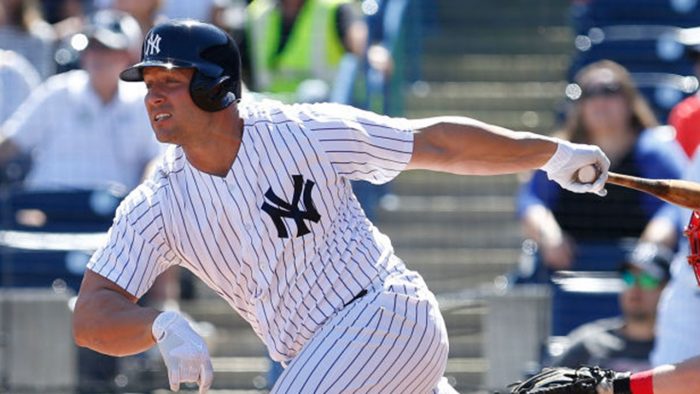
When the Yankees signed Matt Holliday to a one-year, $13 MM deal back in December, the consensus was largely positive. Or, at the very least, a bit better than lukewarm. Holliday was coming off of a down year and was soon to be 37-years-old, but he was probably the best DH option this side of Edwin Encarnacion (who would require a large commitment and a surrendered draft pick) and Carlos Beltran. And that’s before you factor in his reputation as a great teammate and mentor for younger players (insert joke about ‘veteran presents’ here), which was undoubtedly a consideration for the Yankees in the midst of their youth movement.
A bit over two months later, however, the Yankees signed Chris Carter – a player whose best role would be that which Holliday was slated to play. The immediate reaction revolved around DINGERS!, but was followed promptly by questions about when and where the 30-year-old would play. His $3.5 MM salary (along with an extra $500,000 in bonuses based on plate appearances) is veritable chump change to this team (if not all organizations at this point in time, given the influx of cash into Major League Baseball), so it might not matter if he’s riding the bench more often than not. Moreover, there are always injuries: Tyler Austin succumbed to a broken foot already, Greg Bird missed the entirety of 2016 with a torn labrum in his shoulder, and the aforementioned Holliday has missed 50-plus games in each of the last two seasons. Phrased differently, opportunities for playing time are never too far away in the big leagues.
All that being said, the Carter signing – and the subsequent discussions – reminded me of the criticisms hurled at the Blue Jays when they signed Kendrys Morales to a 3-year, $33 MM deal. The signing happened what felt like hours after free agency opened, and was greeted with derision as much better options (including their own Encarnacion) remained on the market. It only looked worse in the weeks to come, as comparable-at-worst DH options were scooped up on cheap one-year commitments, eventually turning disastrous when Encarnacion signed with the Indians for 3-years, $60 MM. If it wasn’t clear that the Blue Jays jumped the gun way back in November, it certainly was once the new year rolled around.
And so the question becomes whether the Yankees jumped the gun with Holliday.
It’s a bit different here, on a few levels. The Yankees are not striving to contend this year, so Holliday’s off-the-field qualities mean a bit more to them. Moreover, they didn’t prevent themselves from signing a better option to a comparably superior deal. Carter was better than Holliday last season, but that doesn’t quite matter because (1) they still signed Carter, and (2) the projection systems see them as a toss-up.
Should we be looking at the opportunity cost differently, though?
Holliday will likely earn $9.5 MM more than Carter this year. If the Yankees could have signed Carter to this deal all along, it stands to reason that they would have had at least another $9.5 MM to spend – if not the full $13 MM, considering that Holliday’s deal didn’t prevent them from signing Carter. With that extra money they could have signed Brett Anderson as a reclamation project, or Bartolo Colon, R.A. Dickey, or Jason Hammel to solidify the back of the rotation (or both Anderson and Hammel). Or they could have signed one of Anderson and Jerry Blevins (or Hammel and Blevins, if they had the full $13 MM to spend). There are several permutations out there that would have improved their rotation and bullpen.
This is laden with assumptions, of course. I’m comfortable saying that the Carter deal could have come to fruition regardless, given that the Brewers couldn’t get anything for him at the trade deadline or prior to non-tendering him, but everything else is guesswork. Even so, it seems clear that the Yankees could look better as a whole with Carter as the starting DH and between $9.5 MM and $13 MM invested elsewhere.
Leave a Reply
You must be logged in to post a comment.